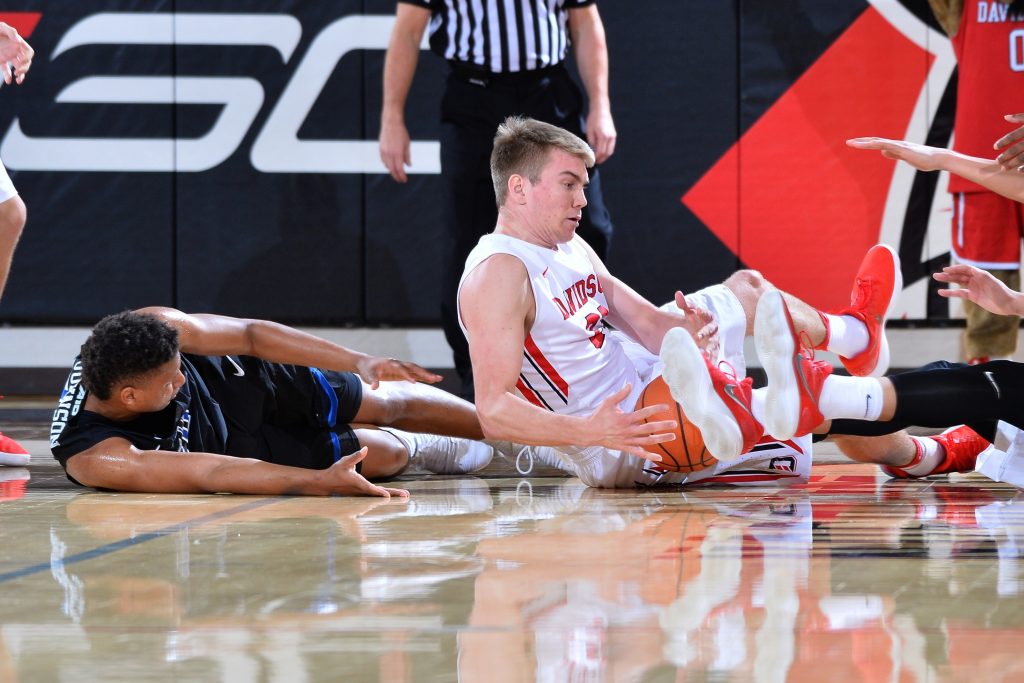In basketball, you often hear of players that have the “intangibles” or a “knack for the ball.” Some might not fill up the box score with points, rebounds, and assists, but still get consistent playing time because they help the team.
Shane Battier, Duke Blue Devil legend, is the most famous example. He did not always have the stats to back his minutes on the court. However, he played in the NBA for 13 years and won two championships. Why? When he was on the court, his team played better.
These qualities are often lumped into the catch-all “hustle.” Battier’s hustle reduced the scoring opportunities of the other team and created plays for his teammates.
Recently, the coaches of the Davidson’s men’s basketball team asked Cats Stats to quantify hustle. Doing so would create a hustle statistic that would more clearly identify these players and their importance.
We discovered that the NBA has its own version of hustle statistics that they were already tracking. The NBA currently tracks the following stats as examples of hustle:
- screen assists,
- deflections,
- loose balls recovered,
- charges drawn,
- contested two- and three-point shots and
- contested shots as examples of hustle.
This was a great start but we had two problems: We believed that other statistics could help quantify a player’s hustle, and the NBA didn’t consolidate these statistics into one score. Therefore, we couldn’t holistically compare one player’s hustle to another.
Because of these already available statistics, we decided to use this head start to first come up with a model to rank the hustle of current NBA players. Then, we figured, if we have a working model for the NBA, we can adapt it to the NCAA and Davidson’s team.
To tackle our first problem, we assembled a list of additional statistics that we thought contributed to hustle. Dr. Tim Chartier (Math and Computer Science Professor, and Cats Stats leader), Dr. Mark Foley (Economics Professor), and the Davidson men’s basketball coaching staff helped us come up with the following:
- steals,
- blocks,
- offensive rebounds,
- contested defensive rebounds, and
- defensive field goal differential (the difference in an opponent’s shooting percentage when guarded by a certain player).
Now, with all these different statistics, we needed a way to combine them to create a single hustle score per player. Fortunately, we ran into another great resource: a 2015 Grantland article. This article assigned a “hustle points” to each of the five statistics based on the probability of the action occurring multiplied by the expected point value of the action. The hustle point value simply determines the number of points prevented or created by a single player. For example, if a two-point field goal is contested, the probability of a two-point field goal going in decreases by 0.05. Thus, the hustle point value is 0.05 x 2, which equals 0.1 hustle points. We adapted this method into our own model using the same logic. Further, by summing up all the hustle points from each statistic for a player, we created a single, cumulative “hustle score” that allowed us to compare different players.
These are our 10 best hustlers in the NBA last season:
| Player | Hustle Score | |
|---|---|---|
| 1 | Giannis Antetokounmpo | 10.32 |
| 2 | Draymond Green | 8.48 |
| 3 | Anthony Davis | 8.48 |
| 4 | DeMarcus Cousins | 8.46 |
| 5 | Patrick Beverley | 8.12 |
| 6 | Marcus Smart | 7.83 |
| 7 | John Wall | 6.06 |
| 8 | Jrue Holiday | 5.53 |
| 9 | Kemba Walker | 5.98 |
| 10 | Robert Covington | 5.44 |
Because of the formula we adopted to create each hustle point, these cumulative scores actually represent the amount of points each player created and saved per game via our definition of hustle.
Some of these players, like Anthony Davis and Draymond Green, are superstars known for their defense and energy. Others, however, are much less well-known. Boston Celtic Marcus Smart is a fascinating example. He doesn’t come close to topping the league in any of the common statistics, like points, rebounds, or assists, but he plays some of the most minutes on the Boston Celtics. During one game, the announcers were confused about why a player who tends to shoot well below average plays so much, and whenever he’s on the court, his team plays better. Well now we found an answer: his hustle.
This article is written by George Baldini and Kendall Thomas. George and Kendall are junior members of Cats Stats and co-direct our heat maps group for men’s basketball.



